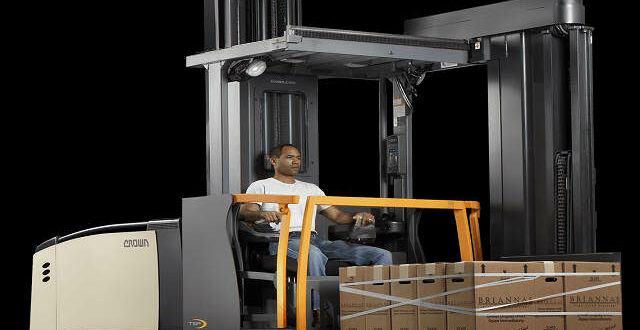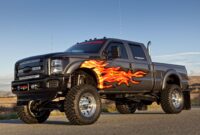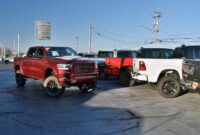Swing Reach Trucks: Navigating Narrow Aisles with Precision and Power cars.truckstrend.com
In the relentless pursuit of maximizing storage capacity and operational efficiency, modern warehouses and distribution centers constantly seek innovative solutions. Among the most pivotal material handling equipment in this quest is the swing reach truck, often referred to as a turret truck or articulated mast truck. This specialized forklift is engineered to operate in extremely narrow aisles, revolutionizing the way businesses utilize vertical space and manage high-density storage. Unlike conventional forklifts that require wide aisles to maneuver and turn, swing reach trucks feature a unique mast and fork assembly that can pivot or "swing" 90 degrees, allowing them to pick and place pallets from either side of an aisle without rotating the entire chassis. This distinctive capability makes them indispensable for operations where every square foot of floor space is precious, transforming warehouse layouts and significantly boosting productivity.
The Core Mechanics: How Swing Reach Trucks Work
Swing Reach Trucks: Navigating Narrow Aisles with Precision and Power
The operational genius of a swing reach truck lies in its sophisticated mast and fork design. Instead of a fixed mast, these trucks are equipped with a turret head or articulating fork carriage that can rotate up to 90 degrees in either direction. The truck itself travels linearly down the very narrow aisle (VNA), while the operator uses controls to extend the forks and then swing them perpendicular to the truck’s direction of travel. This allows the forks to access pallet racks on either side of the aisle.
This mechanism eliminates the need for the truck to make wide turns, drastically reducing the required aisle width. Typically, a swing reach truck can operate in aisles as narrow as 6 to 8 feet (1.8 to 2.4 meters), compared to 10-12 feet (3 to 3.6 meters) or more for standard reach trucks or counterbalanced forklifts. The operator often has enhanced visibility, sometimes aided by onboard cameras, to precisely position the forks for picking or placing loads at considerable heights.
Key Benefits of Adopting Swing Reach Trucks
Integrating swing reach trucks into your material handling operations offers a multitude of compelling advantages that can significantly impact a business’s bottom line and operational efficiency:
1. Space Optimization and Maximized Storage Density
This is the primary and most impactful benefit. By enabling aisle widths to be reduced by up to 50% compared to traditional forklifts, swing reach trucks allow warehouses to install more racking and store a significantly higher volume of goods within the same footprint. This effectively defers or eliminates the need for costly warehouse expansions, turning existing space into highly productive storage areas.
2. Enhanced Efficiency and Throughput
The ability to access pallets quickly from either side of a narrow aisle without extensive maneuvering translates directly into faster put-away and retrieval times. This increased efficiency boosts throughput, allowing more products to be moved in and out of storage per hour, which is crucial for fast-paced logistics operations.

3. Versatility in Load Handling
Swing reach trucks are designed to handle a wide array of pallet types and load sizes, from standard pallets to specialized containers. Their robust design and precise controls allow for safe and stable handling of various goods, even at elevated heights.
4. Improved Safety in Narrow Aisles
Operating in tight spaces naturally raises safety concerns. However, swing reach trucks often incorporate advanced safety features. Enhanced visibility (especially with man-up models or camera systems), precise control, and the elimination of complex turning maneuvers within the aisle reduce the risk of collisions with racking or other equipment. Their stability, even at high lifts, contributes to a safer working environment.
5. Potential for Cost Savings

Beyond the obvious savings from reduced real estate needs, the increased efficiency can lower labor costs per unit moved. Furthermore, optimized space utilization can lead to lower heating, cooling, and lighting costs for the overall warehouse area dedicated to storage.
Types and Configurations of Swing Reach Trucks
Swing reach trucks come in several configurations to suit diverse operational needs:
- Man-Up vs. Man-Down:

- Man-Up (Operator Elevating): The operator platform elevates with the forks, providing a direct, eye-level view of the load and the rack opening. This is ideal for very high lifts and for order picking applications where the operator needs to handle individual items.
- Man-Down (Operator Ground Level): The operator remains at ground level while the forks elevate. Vision is often aided by cameras and monitors. These are typically used for full pallet handling where precise eye-level alignment isn’t as critical.
- Load Capacity and Lift Height: Available in various capacities (from 2,500 lbs to over 5,000 lbs) and lift heights (up to 50 feet or more), catering to different storage requirements.
- Guidance Systems: Many VNA operations utilize guidance systems to ensure the truck travels perfectly straight down the narrow aisle, freeing the operator to focus solely on load handling. Common systems include wire guidance (embedded in the floor), rail guidance, or laser guidance.
Implementing Swing Reach Trucks: Important Considerations
While the benefits are substantial, successful integration of swing reach trucks requires careful planning and consideration of several factors:
1. Warehouse Design and Infrastructure
- Aisle Width: The most critical factor. Aisles must be precisely measured and maintained to accommodate the truck.
- Floor Flatness and Levelness: VNA operations demand exceptionally flat and level floors to ensure stability and precise operation, especially at high lifts. Any undulations can compromise safety and efficiency.
- Racking System: Racking must be robust and precisely installed to handle the loads and potential close proximity of the trucks.
- Lighting: Adequate, uniform lighting is essential for visibility, particularly for operators working at height.
2. Specialized Operator Training
Operating a swing reach truck is significantly different from a conventional forklift. Operators require specialized, in-depth training that covers:
- Precise maneuvering in narrow aisles.
- Understanding the swing mechanism and controls.
- Load stability and weight distribution at height.
- Emergency procedures.
- Proficiency with any guidance or camera systems.
3. Maintenance and Servicing
Swing reach trucks are complex machines with advanced hydraulic, electrical, and electronic systems. Regular, preventative maintenance is crucial to ensure optimal performance, longevity, and safety. Access for servicing within narrow aisles should also be considered in the warehouse layout.
4. Load Handling and Stability
Operators must be highly aware of load centers, weight capacities, and proper fork positioning to maintain stability, especially when lifting to extreme heights. Overloading or improper load placement can lead to dangerous situations.
5. Integration with Warehouse Management Systems (WMS)
For maximum efficiency, swing reach truck operations should be seamlessly integrated with a WMS. This allows for optimized put-away and retrieval routes, real-time inventory tracking, and efficient task management, ensuring the right product is accessed at the right time.
Practical Advice for Optimizing Swing Reach Truck Operations
To truly harness the power of your swing reach trucks, consider the following practical advice:
- Implement Robust Pre-Shift Inspections: Daily checks of brakes, steering, hydraulics, forks, safety features, and battery charge are non-negotiable.
- Adhere Strictly to Load Limits: Never exceed the truck’s rated capacity or the racking system’s capacity.
- Master the Guidance System: If equipped, operators should fully understand and utilize the aisle guidance system to maintain straight travel and focus on the load.
- Continuous Training and Certification: Regular refresher courses and ongoing training ensure operators remain proficient and up-to-date on best practices and safety protocols.
- Optimize Battery Management: Implement a proper battery charging and rotation schedule to maximize battery life and minimize downtime.
- Maintain Clean and Clear Aisles: Obstructions in narrow aisles can be dangerous and disrupt operations. Ensure aisles are always clear of debris and spills.
- Utilize Technology: Leverage onboard cameras, proximity sensors, and WMS integration to enhance safety, accuracy, and efficiency.
Swing Reach Truck Price Guide
The cost of a swing reach truck can vary significantly based on brand, capacity, lift height, features (e.g., man-up vs. man-down, guidance system), and whether it’s new, used, or rented. The table below provides a general estimate.
| Category | Price Range (USD) | Key Factors / Notes |
| New (Entry-level) | $50,00 $ – $70,000 $ | Basic models, lower capacity, lower lift height. |
| New (Mid-range) | $70,000 $ – $100,000 $ | Increased capacity, better lift height, more features.



